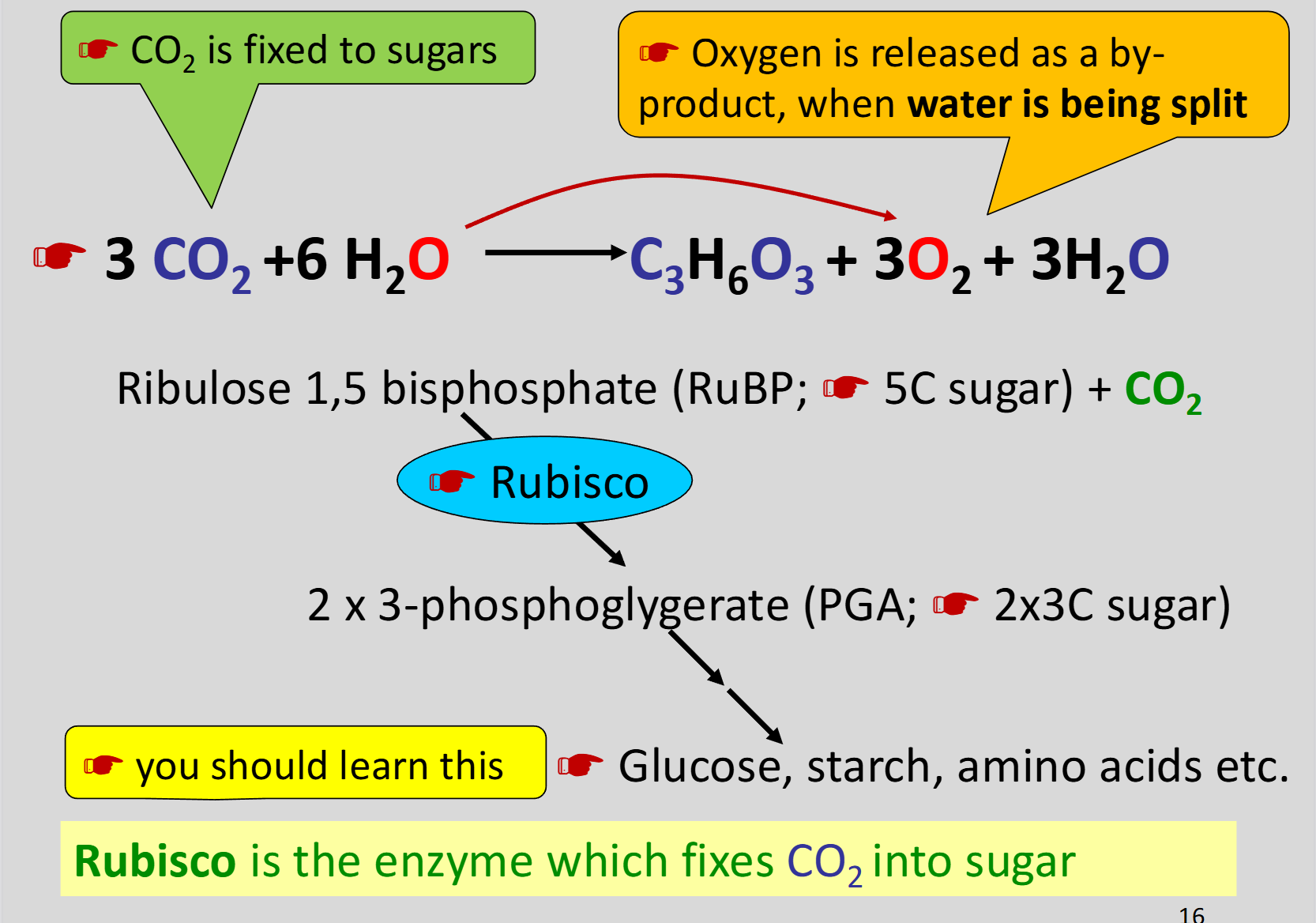Autotrophs
1/34
There's no tags or description
Looks like no tags are added yet.
Name | Mastery | Learn | Test | Matching | Spaced |
|---|
No study sessions yet.
35 Terms

Autotrophs
assimilate CO2 into organic molecules
and living tissue
Photoautotrophs
use solar energy to convert CO2 into organic molecules in photosynthesis
Chemoautotrophs
use energy derived from oxidation of inorganic
atoms such as S, S2- or Fe2+ to convert CO2 into organic molecules in chemosynthesis 5
Energy fixed by —————- can
be liberated in ——— (including
decomposition) or ———
photosynthesis, respiration, combustion
What biome contributes the most to the global NPP
The tropics
When is Global Net Primary Production increasing
Warmer Temp
where does Photosynthesis happens
chloroplasts
What’s the photosynthesis chemical
Ribulose 1,5 bisphosphate also 3CO2 + 6HO2 = C3H6O3 + 3O2 + 3H20
List the chain of event of chemical photosynthesis
(RuBP; ☛ 5C sugar) + CO2, Rubisco, PGA; ☛ 2x3C sugar)Glucose, starch, amino acids etc
Rubisco
The most abundant enzyme on earth,contains lots of nitrogen. Plant N-nutrition important for primary production
Photosynthesis requires gas exchange between
mesophyll cells and atmosphere: happens in
stomata Tradeoff between carbon gain and loss of water: Open stomata to acquire C lead to loss of H2O
Midday depression:
a reduction of photosynthesis during the hottest hours of a day caused by closing of stomata in order to save water.
Amount of photosynthesis in an ecosystem depends on the leaf area:
More leaf area → higher productivity.
Leaf Area Index (LAI) =
total leaf area per projected ground area, LAI expresses how well vegetation uses the available sunlight
LAI generally varies between 0.5 and 15 m2 per m2. why is it important
Productive environment have a high LAI.
Stressed environments have low LAI
Consequently, shade leaves generally have a larger
area per leaf dry mass = a higher specific leaf area* (SLA).
Advantage of high SLA:
Large area to capture photons per invested mass.
Advantage of low SLA:
Sturdy leaves, more efficient use of photons in full sunlight.
Individual response
Phenotypic plasticity helps a given genotype or species to acclimate to certain environmental conditions in a short term (adjustment)
Population response; Evolution
Genetic variation within and among species is
largely a long-term adaptation to certain
environmental conditions.
Photosynthesis is the process in which
photoautotrophic organisms, such as green plants, capture the energy of sunlight. This energy drives most ecosystems.
Photosynthesis can be limited by other factors then light, such as
drought, lack of mineral nutrients (N, P, K, etc.) or
low temperatures.
Plants show morphological and physiological ——————- in their photosynthetic characteristics in response to environmental conditions
adaptations and acclimation
Important variables for of ecology of photosynthesis are
LAI (in context of ecosystems) and SLA (in context of
individual plant species).
Important molecules for life
Carbon
Oxygen
Hydrogen
Nitrogen
Sulfur
Phosphorus Carbohydrates Proteins
Potassium important in plants for
osmotic regulation,
e.g., in stomatal guard cells, and fruit ripening.
Cytochrome c is an important protein
in electron transport chains associated with photosynthesis, and with respiration. (plants need iron like me!)
Laccases:
copper-containing oxidase enzymes in
many plants, fungi, and microorganisms.
Laccases play a role in the formation and
degradation of lignin.
Senescence happens e.g. when
plants prepare for an
unfavourable season, or when they remobilize the
nutrients to a more useful location, such as from
shaded leaves to sun-exposed leaves.Plants withdraw most of the nutrients from senescing
leaves. But the withdrawal cannot be complete, some
nutrients remain in the falling leaves and will be lost
Both leaf longevity and nutrient withdrawal from
senescing leaves help the plant
to conserve nutrients
Longevity can be obtained by investment in
tough
tissue and protective structures, which reduces growth.
Rate-of-living theory for animals
A negative relationship
between basal metabolic rate
and maximum life span for
mammals and birds has been
indicated.
fast growth an advantage on frequently disturbed sites:
Fast occupation of empty space. No conservation of
resources because they may soon be lost.
Longevity is an advantage in undisturbed sites:
in the long term resource conservation is more
important than fast occupation of space